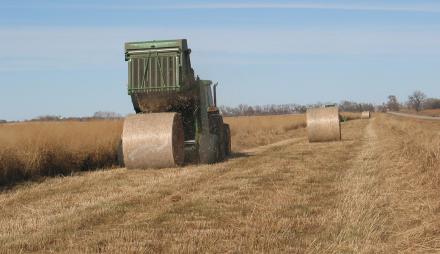Cashing In On Marginal Lands
The United States has more than 2 million farms, of which 98% are family farms that account for 88% of U.S. farm production. That’s a lot of land and a lot of production, but, for decades, nearly 7 in 10 American farms have hovered in the financial “critical zone.” A farm is considered to be in the critical zone if operating profits are less than 10% of its gross cash income.
Given that large farms tend to have higher profit margins, what can small operators do to remain in business? Scientists with the Agricultural Research Service (ARS) may have found a way for farmers to capitalize on land previously thought to be unproductive, and even help the environment while they’re at it.
Their solution? The farmers can grow, harvest, and sell switchgrass. Study findings are available in the Jan. 15, 2024, edition of Frontiers in Energy Research.

Switchgrass being harvested. (Photo by Robert Mitchell)
Switchgrass produces a large amount of biomass, and that’s where it can help farmers pad their profit margins. According Rob Mitchell, co-author of the study and agronomist at the ARS Wheat, Sorghum, and Forage Research unit in Lincoln, NE, switchgrass is not a one-size-fits-all bioenergy feedstock, but it is the most advanced herbaceous perennial feedstock.
“We believe marginally productive land is best defined by its economic parameters,” Mitchell said. “A good working definition for the western Corn Belt is sites that are more than 25% below the average dryland corn production for [its] county. For example, using this definition, non-irrigated pivot corners (areas of a field not reached by circular pivot-arm irrigation systems) may be marginally productive in most crop production years.”
A center-pivot irrigation system located on a square 160-acre plot typically irrigates a circular area of only 132 acres, leaving 28 acres of dry cropland in the four corners. Because those corners rely solely on rain, the land cannot reliably be considered productive.
Mitchell noted that the Upper Big Blue Natural Resource District in eastern Nebraska is heavily irrigated with center pivots. This area alone could grow 50,500 hectares (about 126,000 acres) of switchgrass in pivot corners, enough to supply a 50 million-gallon-per-year ethanol biorefinery.
In addition to selling switchgrass as a biofuel feedstock, farmers can sell – and have sold – switchgrass as animal forage, like hay.
Among the characteristics that make switchgrass appealing as a crop is its perennial nature – it does not require annual planting, needs fewer chemical inputs (pesticide and fertilizer) than traditional row crops, is not irrigated, and provides important ecosystem services.
Those ecosystem protective services include preventing soil loss from wind and water erosion by providing root systems that stabilize fragile soil; rapidly increasing soil organic carbon; and increasing soil density. In addition, switchgrass for bioenergy is net energy positive, and average greenhouse gas emissions from switchgrass-based ethanol are 94% lower than emissions from gasoline.
“I think it would be cool for us to grow our own transportation fuel while simultaneously improving the environment, providing critical wildlife habitat, and giving farmers more opportunities to generate revenue,” Mitchell said. – by Scott Elliott, ARS Office of Communications

